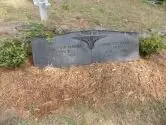Cemetery Adventures

I grew up in a cemetery.
Three cemeteries, in fact.
Growing up in a small Scandinavian town (population 850) on the Illinois prairie, I always assumed that every town had three cemeteries: one for the Lutherans, one for the Presbyterians, and one out in the country for those who didn’t care.
Much later, I realized that the choice wasn’t quite that simple, but for a ten-year-old boy with a Schwin bike with unlimited miles, it made perfectly good sense. Ray Bradbury thought so, too, in Dandelion Wine, which should be read every Spring before you first lace up your walking shoes.
As a Norman Rockwell Boy Scout, I marched out to each of the two town cemeteries on Memorial Day, daydreamed while the two ministers took turns delivering what was supposed to be a short sermon, then braced myself for the uniformed American Legion veterans of World War II and the Korean War firing off three volleys from their worn carbines. It was followed by the playing of taps by my dad’s best friend “Bub” Roquet, and the haunting repeat echoed back from behind the hill by our first chair trumpet player, Mike McGaughey.
About that same time I got the job of mowing the country cemetery, named the Hopewell Cemetery after one of those even smaller prairie towns that dried up and blew away like a tumbleweed during the Great Depression, leaving behind only a cluster of tipsy tombstones atop a pine-shrouded knoll surrounded by swaying corn fields. On Saturday my dad would drop me off at the cemetery three miles outside of town, fill the push mower with gas, make sure it started, and leave me, my thermos, and the lunch box my mom had packed for the day, coming back to pick me up at five, at which time I would have mowed and trimmed the entire cemetery.

Needless to say, I came to know my town’s ancestors — including my grandparents on the Johnson side — very well.
So last week, when I returned to the small town of Tryon, NC, to do more research on Miss Eleanor Vance and Miss Charlotte Yale, the 54-year life partners who started both Biltmore Industries and Tryon Toymakers & Woodcarvers (both Arts and Crafts cottage industries), I naturally drove out to the Tryon Cemetery to find their gravestone.
And when I saw how darkened, discolored, and forlorn it looked, I began making plans to return. The following week I arrived just after the sun had risen and went to work, carefully scrubbing the granite face, gradually releasing their names and dates from beneath sixty years of stubborn algae, tree sap, bird droppings, and grime, digging holes with my shovel at either end for two azaleas shrubs (the ladies loved gardening), hoping all the while I would not be mistaken by a nosy neighbor for a grave robber, and, finally, outlining their stone and the two fresh, green azaleas with two bags of shredded cypress mulch.
About the time the town awoke and the morning walkers hit the streets, I was done, justifying my actions with the familiar adage, “It is easier to beg forgiveness than to ask permission.”
I told no one (except the 35,000 of you), so lets keep it that way, in case the Tryon town council should not look so approvingly upon my dawn exploit.
“Area Man Arrested For Defacing Cemetery”
(Psychiatric Examination Scheduled)

Until next Monday,
“Do something everyone thinks you shouldn’t.”
Bruce
